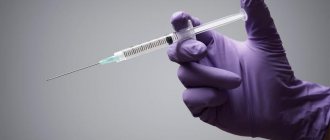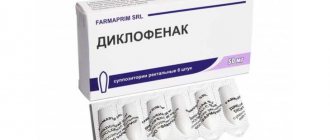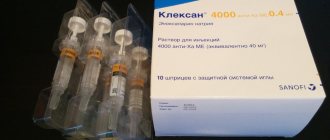Diclofenac has been used throughout medicine for many decades, and during this time the drug has established itself as a reliable remedy, balanced in all respects. One of the significant forms of drug release is ampoules with diclofenac solution, used in particularly complex clinical cases.
General characteristics of the drug
To treat pathologies of the musculoskeletal system, Diclofenac tablets, ointments, gels or suppositories can be used. All forms of release of the drug have a similar effect, often combining external treatment with its systemic administration. Tablets are available in dosages of 25 and 50 mg; recently, Diclofenac Retard containing 100 mg of the active substance can be found on sale. Since the tablet form of the drug can have a damaging effect on the gastrointestinal tract, and the effect does not occur immediately, Diclofenac injections are often prescribed for acute pathologies.
The main active ingredient of the drug is the sodium salt of phenylacetic acid. It is she who has the ability to bind arachidonic acid, which is responsible for the production of prostaglandins, which cause the inflammatory process.
To quickly relieve pain and inflammation, it is better to use Diclofenac in ampoules. Usually 1 or 3 ml of the drug is administered. Each 3 ml ampoule contains 25 or 75 mg of active ingredient. The drug in this form is a clear solution with a slight odor of alcohol. In addition, the drug contains water for injection, propylene glycol, pyrosulfite and sodium hydroxide and benzyl alcohol.
The effectiveness of this drug is explained by the peculiarities of the action of the main component. It has an analgesic, anti-inflammatory and antipyretic effect. With intramuscular administration of this drug, relief quickly occurs. After 15–20 minutes, pain decreases and swelling subsides. Therefore, such injections are prescribed for acute conditions, for example, for pain in the back, muscles or joints caused by rheumatic diseases, chronic pathologies or injuries.
The effectiveness of the drug is also explained by its other properties. In addition to reducing pain and eliminating the inflammatory process, Diclofenac is able to improve blood circulation in the damaged area of the musculoskeletal system and improve the production of intra-articular fluid. It relieves swelling of joints and improves the elasticity of ligaments. Therefore, the drug can partially stop degenerative processes and restore mobility of the joints and spine.
When treating with this drug, you need to remember that Diclofenac helps effectively against pain, but does not eliminate the cause of the disease. Usually, several injections are prescribed until the acute inflammatory process is relieved, and then another treatment is applied aimed at eliminating the cause of the pathology.
Important: you cannot use Diclofenac on your own; you must first be examined by a doctor.
Analogues and prices
Direct analogues of Diclofenac can be considered its generics, based on the same active ingredient: dichlorophenylaminophenylacetic acid. Among the most well-known competitors are the Swiss Voltaren with the same dosage, the domestic Diclofenac-AKOS and Diclofenac-Solopharm, as well as the Israeli Diclonat.
As for analogues of action, which belong to the class of NSAIDs with an analgesic effect, the most popular drugs on the Russian market are the following:
- Glucosamine;
- Don;
- Elbona;
- Xefocam;
- Movalis;
- Dexalgin;
- Artoxan;
- Kenalog;
- Meloxicam;
- Ketorolac;
- Artradol;
- Ketonal.
It should be noted that any anti-inflammatory drugs in ampoules can be purchased at the pharmacy only according to a prescription. The approximate cost of drugs is contained in the following table:
| Name | Price, rub.) |
| Diclofenac | 100 |
| Don | 1300 |
| Elbona | 1300 |
| Xefocam | 800 |
| Movalis | 600 |
| Dexalgin | 500 |
| Artoxan | 550 |
| Meloxicam | 300 |
Indications for use
Many people who often suffer from back pain are familiar with this drug. But it is mainly used in the form of ointments or tablets. Injections are an emergency remedy used during an attack of acute pain when it cannot be relieved by other means. Therefore, what Diclofenac injections help with is mostly known to older people suffering from radiculitis or chronic sciatica.
Diclofenac injections are effective for acute back pain
It is advisable to use the injection form of the drug as prescribed by a doctor. But some patients with chronic pathologies know the indications for the use of Diclofenac and always keep ampoules of this product at home to use them as needed.
This drug is most often used in the following cases:
Diclofenac and its release forms
- for radiculitis, sciatica or lumbago;
- inflammatory pathologies of joints of rheumatic or infectious origin;
- reactive or psoriatic arthritis;
- Bekhterev's disease, seronegative spondylitis;
- gout in acute form;
- polyarthritis;
- bursitis, tendovaginitis, synovitis;
- arthrosis or deforming osteoarthritis of the joints;
- algodismenorrhea;
- herniated intervertebral discs;
- with osteochondrosis;
- neuralgia;
- muscle pain;
- migraine attacks;
- to relieve renal, biliary or hepatic colic;
- after operations;
- after injuries associated with sprain or rupture of ligaments, dislocation or fracture.
pharmachologic effect
The main active ingredient of the drug Diclofenac is a derivative of phenylacetic acid. It stops the release of arachidonic acid from damaged cells, thereby slowing down and stopping the inflammatory process. The drug normalizes blood circulation, restores the active movement of blood plasma cells, blocks the synthesis of inflammatory mediators, which leads to a reduction in pain. Relieves joint swelling by normalizing the formation of intra-articular fluid.
Contraindications and side effects
Diclofenac is a potent drug that can cause serious consequences if used incorrectly. Therefore, before prescribing an injection, the doctor must take into account the contraindications specified in the instructions for use of the drug.
There are some pathologies for which this remedy should absolutely not be used:
- peptic ulcer, especially for the tablet form;
- hypersensitivity to the components of the drug or to acetylsalicylic acid;
- bronchial asthma;
- severe blood diseases, for example, hemophilia or other pathologies leading to deterioration of blood clotting;
- children under 15 years of age;
- during pregnancy and during breastfeeding.
In addition, there are some pathologies for which such injections can be given, but only under the supervision of a doctor and in a smaller dosage. These are heart failure, arterial hypertension, cerebral vascular pathologies, severe liver or kidney diseases, hemorrhoids or proctitis. This treatment is also used with caution for systemic lupus erythematosus, Crohn's disease, and colitis. Dose adjustment is required for elderly people, weakened or debilitated patients. Namely, in these cases, it is most often necessary to quickly relieve pain in the back or joints.
Important: such people can use Diclofenac in injections only after consulting a doctor.
In addition, despite the fact that the drug is indicated for relieving postoperative pain, it is used very rarely in such cases, as it can cause increased bleeding. Pregnant women also need to be careful with such injections. Such drugs easily penetrate the placental barrier, so they can seriously harm the baby. Sometimes in the first or second trimester, the doctor may decide to administer Diclofenac if the benefits of such an injection outweigh the possible risk to the fetus. But in the third trimester it is not used under any circumstances, as it can cause discoordination of labor. This leads to serious complications during childbirth, bleeding and the risk of hypoxia in the fetus.
Some patients are strictly prohibited from receiving Diclofenac injections
If used incorrectly, or if the dosage or other doctor’s recommendations are not followed, side effects may develop after such an injection. The drug is administered intramuscularly, so it quickly spreads throughout the body, affecting all organs and systems. The most common negative reactions to this treatment include upset stomach, abdominal pain, nausea, loss of appetite, flatulence and diarrhea. Headaches, weakness and drowsiness are also common. Vision and hearing may temporarily deteriorate, insomnia, depression, and confusion may appear. Such side effects occur especially often in people who drink alcohol or smoke less than a day before the injection.
People with individual intolerance quickly develop allergic reactions to the administration of the drug. In this case, it cannot be used. If the drug is injected by a non-professional, an abscess on the skin or necrosis at the injection site may develop. More serious side effects of such treatment include impaired renal function, expressed in a decrease in their activity, impaired urination and the development of edema. Cramps in the arms and legs may also occur.
There may be a strong increase in blood pressure and a deterioration in blood clotting, leading to the risk of internal bleeding. Because of this, anemia may develop. And if the patient has a peptic ulcer, this can lead to perforation of the ulcer and peritonitis. Quite rare side effects that develop mainly with overdose include the development of gastritis, colitis, pancreatitis, hepatitis, stomatitis, and proctitis.
Where and how to give the injection
Each package contains instructions for using Diclofenac in ampoules. In order to give injections correctly when using Diclofenac (solution), the instructions must be studied in detail. But it may not be enough, so you can consult a doctor or nurse.
The dosage is calculated for each patient separately, depending on the diagnosis and health status.
If a person has chosen a Diclofenac injection for treatment, the instructions for use contain different methods of administration:
- Diclofenac is a solution for intramuscular administration. This means that a person gets an injection in the buttock at home. To do this, select the upper distal square, piercing the skin approximately in the middle. For subsequent injection, choose a different location on the buttock so as not to increase the pain syndrome. Often the medicine is injected into the leg or forearm.
- Intravenous administration of Diclofenac injections. The doctor squeezes the veins on the arm, inserts a needle, and slowly injects the medicine. After the effect ceases, the syringe is removed and antiseptic treatment is performed.
- Dropper. The syringe is inserted directly into the dropper and the drug is slowly injected. It is administered in the amount prescribed by the doctor. It is not recommended to do this yourself.
The adult dose for injection should not exceed 150 mg in 1 day. More often, doctors prescribe 1 ampoule, which contains 75 ml of the product. Otherwise, the risk of adverse reactions that worsen the patient’s health increases. Diclofenac injections must be given in courses.
For this, 5 procedures are used.
Many patients are bothered by complaints of back pain after 50-60 years. They need to know how to inject Diclofenac for lower back pain. This should be done in the amount of 1 ampoule with slight pain. If the attack does not go away or gets worse, it is recommended to use 1 more ampoule.
How to breed
The medicine is diluted in saline solution. Take 75 mg of the product and mix with 100 ml of sodium chloride. If you use Diclofenac in ampoules - 25 mg for every 1 ml of liquid. 1 ampoule contains 75 mg of liquid, which is diluted in saline solution.
The drug in its pure form can cause side effects and acute pain in the patient. Even if the drug is diluted, it is not recommended to use it for a long time. Vascular necrosis and tissue perforation may develop.
How often and for how many days can you inject?
The course of treatment depends on the patient's diagnosis. To eliminate pain, you need to inject every day:
- pain and morning stiffness of joints - no more than 150 mg of the drug;
- dysmenorrhea - from 50 to 150 mg 1 time per day;
- patients with slight depletion of the body from illness - 50 mg of medication without further adjustment;
- people with cardiovascular, renal, hepatic pathologies - reduce the dosage to 100 mg per day.
What do you think are the most important factors when choosing a medical facility?
Diclofenac should be injected for back pain when the disease worsens. In most people after 60 years of age, inflammatory processes become chronic. Therefore, you can give Diclofenac injections when an attack occurs.
If pain occurs in the lower back, a comprehensive examination should be performed.
This symptom may be associated with disorders of the reproductive system and pinched nerve tissue.
In this case, you can inject Diclofenac for lower back pain, but with complex therapy of the primary disease.
To reduce the load on the kidneys and liver tissue, it is recommended to inject Diclofenac intramuscularly, but not intravenously. This allows the medicine to spread more slowly into the bloodstream. The injection can be given every other day.
In order not to harm the body, you should know how often you can inject Diclofenac. If you exceed the course of treatment for more than 5 days, severe consequences for the body develop.
Features of use during pregnancy and for children
Injections are used for children in reduced dosages. It is calculated for each kilogram of body weight, 0.5-2 mg of medication. If the child has an autoimmune disease, the dosage can be increased to 3 mg. If your body weight is large, it is forbidden to consume more than 150 mg per day.
Diclofenac during pregnancy is used until the beginning of the 3rd trimester. This is due to the fact that no drug research has been conducted in this area.
In the 1st and 2nd trimester, you can take Diclofenac in minimal dosages (50 mg per day) - only as prescribed by a doctor, if the effect obtained is higher than possible side effects.
Painful injections or not
If the patient is given injections according to all the rules, he does not feel pain when the drug is administered.
It can only occur when a needle punctures the skin and soft tissue.
How long does it take to work?
If you use Diclofenac in the form of tablets, suppositories, ointments, the effect occurs within 30-40 minutes.
When injected, the drug begins to act within a few minutes after administration. This is due to the fact that it directly enters the bloodstream.
Instructions for use
Injecting Diclofenac for pain in the lower back or joints can only be prescribed by a doctor. Moreover, the injection must be given by a professional. If the patient does not have the opportunity to contact a medical professional for an injection, it is better to choose another form of release of the drug. But even if friends or relatives can give the injection to the patient, Diclofenac in this form can only be used after consultation with a doctor. It is very important to follow the dosage of the drug prescribed by the doctor, as well as the duration of treatment.
Use during pregnancy and lactation
In the 1-2 trimesters of pregnancy, the use of the drug threatens the formation of congenital pathologies in the embryo, and in the 3rd – fetal hypoxia and its death. In addition, Diclofenac negatively affects the contractile function of the uterus, which increases the likelihood of postpartum hemorrhage. Much depends on how many milligrams of the drug you take. In small doses and only after consultation with a specialist, it is permissible.
Duration of treatment
Typically, the course of treatment with Diclofenac injections is 3–5 days. A maximum of 3 injections of 3 ml each can be given per day. But this is done only if there is an urgent need for severe pain. After all, even if these rules are followed, an overdose is possible. In this case, disruption of the gastrointestinal tract and damage to the nervous system quickly develop. Treatment of overdose is symptomatic, and the drug must be discontinued immediately.
To prevent the development of side effects, it is better to take the drug no more than once a day. And the question of how many days you can inject Diclofenac can only be decided by a doctor. This is usually determined individually depending on the severity of the patient's condition. Injections are given until the patient's health condition improves. Most often it takes 3–5 days, but sometimes one injection is enough. After this, it is recommended to switch to other forms of the drug, most often tablets. Only in case of severe chronic pain, the doctor may decide to extend injection therapy, but not more than 2 weeks. In this case, it is best to inject Diclofenac every other day, combining it with the use of other drugs - analgesics or non-steroidal anti-inflammatory drugs.
Attention: this treatment is carried out in a hospital setting, since constant monitoring of important vital signs is necessary, the results of blood tests and ECG must be taken into account.
Why is Diclofenac injection dangerous?
The danger of Diclofenac injections is manifested in the risk of complications:
- local - suppuration, abscess of the buttock, destruction (necrosis) of tissue;
- allergic reactions - from rash to bronchospasm, suffocation, rapid development of swelling of the face and respiratory tract;
- irritation of the mucous membrane of the stomach and intestines, development of inflammation, ulcerative defect, bleeding;
- deterioration of the kidneys and liver;
- swelling and increased blood pressure;
- changes in blood clotting - a tendency to bleeding, but there is also a possibility of thrombosis with the development of a heart attack or stroke.
Diclofenac should not be injected in the 3rd trimester of pregnancy, as the risk of bleeding, weakness of labor, and heart defects in the child increases.
We recommend reading why my leg went numb after an injection of Diclofenac. From the article you will learn about the causes of the phenomenon, what to do and who to turn to for help. And here is more information about what you need to know before you start taking Diclofenac tablets.
For back pain
Diclofenac is the most common drug used for cervical osteochondrosis, radiculitis, hernia or sciatica. This is due to its high availability and efficiency. Relief from back pain occurs within 15 minutes, and after half an hour the pain goes away. Its only drawback, as many patients believe, is that its effect lasts no more than 8 hours. Then you will need to do a second injection, and this threatens the development of side effects.
For various pathologies of the musculoskeletal system, many doctors choose Diclofenac
Composition and properties
Comparing the drug with other NSAID medications, pharmacists note that it has a weaker effect on the gastric mucosa. Injections with anti-inflammatory, antipyretic and analgesic effects quickly block arachidonic acid. It is a provocateur of inflammation. Diclofenac prevents the development of a chemical reaction that promotes vasodilation and the appearance of edema.
Injections inhibit the action of cyclooxygenase, inhibiting the synthesis of prostaglandins. Diclofenac is considered a good antiplatelet agent. The drug restores joint function in adult patients and adolescents, reducing the risk of complications of the inflammatory process.
Since the maximum concentration of the active substance is reached in the circulatory system 20-30 minutes after administration, the drug effectively prevents relapse of pain. A similar effect is observed for about 12 hours.
The half-life of the active component takes up to 2 hours. Excipients take longer to be eliminated. The main metabolism occurs in the liver. A significant amount of breakdown products is excreted in urine and feces.
How to prick correctly
Diclofenac can only be injected intramuscularly. The injection is made into the gluteal muscle in its upper outer quarter. It is best to inject with a long needle, so that when the subcutaneous layer is punctured, it enters the muscle at least three-quarters of the way. You need to use a 5 mm syringe. Before administration, the ampoule with the drug should be held in the palms of your hands so that its contents warm up. This will speed up the absorption of the active substance, increase its effectiveness, and also reduce pain during the injection.
Attention: it is prohibited to administer Diclofenac subcutaneously or intravenously.
The injection of Diclofenac should be long. This means that you need to release the solution slowly. Otherwise, severe pain will appear at the injection site and the risk of side effects will increase. If it is necessary to re-administer the drug, the injection is given in the other buttock, constantly alternating them to prevent the development of infiltration. Failure to follow the rules for administering the medication or choosing the wrong syringe and needle can result in the medication getting into the subcutaneous tissue. And this threatens the development of an abscess or even tissue necrosis.
Side effects
First of all, you need to pay attention to the most common, from a statistical point of view, adverse reactions from the use of Diclofenac in ampoules. Thus, patients risk encountering:
- headaches;
- dizziness;
- vertigo;
- abdominal pain and dyspeptic complex;
- skin rash;
- pain at the injection site.
Infrequent adverse reactions include myocardial infarction, heart failure and tachycardia. Experts note that to reduce the risk of unwanted side effects, you should use the minimum effective dosage and undergo the shortest possible course of treatment.
What to combine the drug with
The peculiarities of the action of Diclofenac do not allow it to be used in combination with some other medications, even in tablet form. It is especially dangerous to combine this drug with other non-steroidal anti-inflammatory drugs. This increases the risk of side effects. And acetylsalicylic acid reduces the concentration of Diclofenac, which leads to a deterioration in its effectiveness. It is also not recommended to use this drug for those undergoing treatment with glucocorticosteroids.
Due to Diclofenac's ability to reduce blood clotting, it is not advisable to use it in combination with anticoagulants. This leads to an increased risk of bleeding. Caution is recommended for such treatment in patients with hypertension, since Diclofenac may impair the effectiveness of antihypertensive drugs. And when used simultaneously with hypoglycemic agents for diabetes mellitus, hypoglycemia may develop.
Since Diclofenac negatively affects kidney function, it is undesirable to combine it with potassium-sparing diuretics. Combinations with Digoxin, lithium preparations, Cyclosporine, Methotrexate are also prohibited.
special instructions
There is some likelihood of bleeding in the gastrointestinal tract when taking the medication, so at the first signs of this phenomenon, the course of therapy should be stopped. Patients with gastrointestinal diseases are recommended to take gastroprotectors simultaneously with NSAIDs. Some patients have developed an acute allergic reaction to diclofenac sodium.
Two or more types of NSAIDs should not be prescribed simultaneously. During long-term therapy, it is necessary to regularly check liver function, as well as monitor the possible development of fluid retention in the body. When using Diclofenac, you should refrain from driving vehicles and mechanisms that require an acute psychomotor reaction.
How to choose treatment
When prescribing Diclofenac for pain relief, many patients are interested in how often this drug can be injected. But when they find out that the duration of treatment is no more than 5 days, and no more than 3 injections can be given per day, some try to choose another remedy. After all, sometimes constant therapy is required to relieve chronic pain. In these cases, the doctor will help you choose a safer treatment. These may be drugs Ketanov, Ortofen, Celecoxib, Movalis, Meloxicam.
But most analogues of Diclofenac, related to non-steroidal anti-inflammatory drugs, also have restrictions on the duration of use. Therefore, many patients choose Diclofenac because of its availability and low price. A package of 5 ampoules costs from 40 to 80 rubles.
Overdose
Even with minimal non-compliance with the prescribed daily dose of the drug, the patient may experience characteristic symptoms:
- nausea, vomiting, dizziness up to loss of consciousness,
- convulsions,
- cardiopalmus,
- bleeding,
- pain in the epigastric region.
If an overdose occurs, the following measures must be taken:
- Flushing the gastrointestinal tract, reducing the concentration of toxins.
- Introduction of a large dose of any sorbent that binds and neutralizes toxins.
- Drink plenty of boiled water at room temperature.











